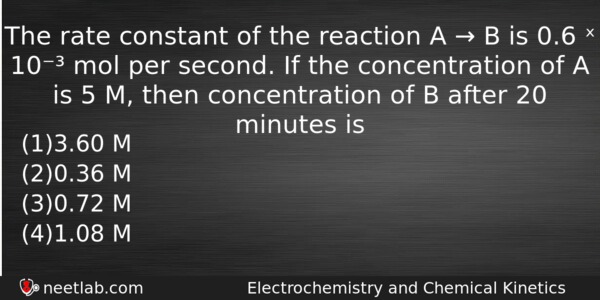| ⇦ | 
| ⇨ |
The rate constant of the reaction A → B is 0.6 ˣ 10⁻³ mol per second. If the concentration of A is 5 M, then concentration of B after 20 minutes is
Options
(a) 3.60 M
(b) 0.36 M
(c) 0.72 M
(d) 1.08 M
Correct Answer:
0.72 M
Explanation:
No explanation available. Be the first to write the explanation for this question by commenting below.
Related Questions: - Which one of the following is the heaviest
- In which one of the following is not a buffer solution
- The pH value of 0.02 M ammonia solution, which is 5% ionised, will be
- Hydrolytic reaction of fats, with caustic soda, is known as
- Which of the following species has four lone pairs of electrons?
Topics: Electrochemistry and Chemical Kinetics
(87)
Subject: Chemistry
(2512)
Important MCQs Based on Medical Entrance Examinations To Improve Your NEET Score
- Which one of the following is the heaviest
- In which one of the following is not a buffer solution
- The pH value of 0.02 M ammonia solution, which is 5% ionised, will be
- Hydrolytic reaction of fats, with caustic soda, is known as
- Which of the following species has four lone pairs of electrons?
Topics: Electrochemistry and Chemical Kinetics (87)
Subject: Chemistry (2512)
Important MCQs Based on Medical Entrance Examinations To Improve Your NEET Score
18000+ students are using NEETLab to improve their score. What about you?
Solve Previous Year MCQs, Mock Tests, Topicwise Practice Tests, Identify Weak Topics, Formula Flash cards and much more is available in NEETLab Android App to improve your NEET score.
Share this page with your friends

Reaction is of zero order as the unit of rate constant is mol L⁻¹ S⁻¹
.·. Concentration of B =k × t =0.6×10⁻³ × 20 × 60 = 0.72 M
Let at time t=0 (A)= a and (B)=0
At time t=(20*60)sec (A)= (a-x) and (B)=x then
For 1st order reaction
(A’) =(A) – kt
: a-x = a – 0.6*10-3*20*60
Solving it will give
X= 0.72 M